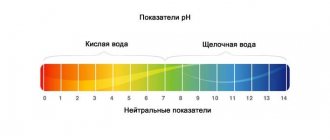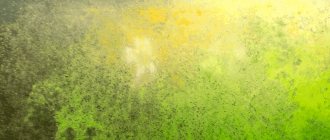An aquarium at home is a small coral reef right in your room. Many people think that getting fish means buying an aquarium and introducing new inhabitants into it. However, experienced aquarists will tell you that in order to create good living conditions for fish, you need to follow some rules. The most common problem that everyone faces is cloudy water. For a beginner, this phenomenon may be puzzling or frightening, but there is no need to worry. In this article we will tell you about all the reasons why this can happen and how to fix the problem.
What causes cloudy water in an aquarium?
Cloudiness of the water in an aquarium can be caused by 2 factors - natural cloudiness and caused by the fault of the aquarist. The sooner the cause of the “fog” is determined, the safer it will be for the fish. Let's look at the main causes of cloudy water in an aquarium and their solutions.
Bacteria reproduction
Most often, active proliferation of bacteria occurs when water is turned on. At this moment, conditions for the life of fish begin to form in the aquarium. During this period, fungi and bacteria multiply rapidly. Due to inexperience, some people drain the water and add new water, but all you need to do is let it sit for a few days.
Fish cannot be put into such water. It is recommended to fill the aquarium with water at least a few days before introducing the fish. After a few days, the cloudiness will go away and you will see clear aquarium water, where conditions for the life of fish are fully created.
Recommendation: Before starting fish, the water and soil must settle. At this time, processes occur in the water that create a favorable habitat for fish.
Low quality food and overfeeding of fish
If you have several types of fish in your aquarium, then you need to choose food for each one separately. Do not take low quality food, it may contain additives that are useless for fish. Fish do not eat such food, and it settles to the bottom and begins to rot, thereby causing the proliferation of bacteria and, as a result, the water quickly becomes cloudy. Rotting food can also cause ammonia to be released into the water, which is fatal to fish.
Preventing problems from recurring
To avoid unpleasant situations, you just need to follow these recommendations:
Do not overfeed the fish. There should be enough food so that the fish can eat it in 3-5 minutes. Use only high-quality dry food.- Change the water in the aquarium regularly - 30% of the volume weekly.
- Observe the light regime (no more than 12 hours a day).
- Thoroughly wash purchased plants before planting them in the aquarium.
- Use aquarium equipment that is suitable for power.
- Be careful when using chemicals in an aquarium.
Summarize
If you decide to decorate your home with an aquarium, then you should approach this issue responsibly. You create a home and living conditions for several living beings.
- before purchasing, be sure to think about what fish you want to add to your aquarium;
- find a convenient place for the aquarium, out of direct sunlight;
- prepare water, soil and decor in advance;
- prepare special equipment for the aquarium - thermometer, filter;
- consult with the seller what food is suitable for your fish and in what quantity;
- adhere to proportions when feeding.
By following simple maintenance rules, you will not encounter such a problem as cloudy water. And even if this happens, after reading the article, you will know how to solve this issue.
Most aquarists place the problem of algae invasion in the aquarium first after the problem of mass fish death. And this is not surprising - the aquarium, depending on the algae that has attacked it, either becomes like a swamp, or spreads an unpleasant odor, or begins to be difficult to see. To top it all off, plants begin to die en masse. And today I will tell you how you can protect your aquarium from red algae, which are not the most terrible in appearance (sometimes grottoes and stones completely overgrown with them even give a special charm to the aquarium), but the most difficult to remove, quickly spreading and having a detrimental effect on aquarium plants.
Red algae (Rhodophyta) number more than five thousand species, but two of them become an aquarium disaster: the so-called “Blackbeard” (in scientific language Compsopogon) and “Flip-flop” (in scientific language Audeuinella). This algae grows fastest in areas of strong water current.
Why do algae appear?
Before considering some ways to combat them, you need to understand where these algae come from and what conditions are favorable for them. Let's try to do this now, without going too much into scientific terminology.
Algae and their spores most often enter the aquarium with purchased plants, but they can also be introduced with fish, decorations, and even food. Therefore, it is extremely difficult to prevent their appearance in an aquarium; their spores are present, probably, in all aquariums. Another thing is that in some algae you can’t see them at all, while in others they bloom like nettles on an abandoned summer cottage. Why is this happening?
The fact is that in aquariums where balance has been achieved, the algae simply do not have enough nutrition for their development. And, so to speak, their main competitors in the struggle for nutritional resources are plants. Therefore, the more nutrients the noble plants take, the less of them will be available for the impostor algae to feed on. On the other hand, algae, unlike plants, are protozoa, and their rapid growth does not require any long period of time. Therefore, having received a sufficient amount of nutrition, they immediately begin to take over the entire aquarium space, thereby inhibiting the growth of plants.
What is the main condition for the colonization of an aquarium by algae? The first is an increased content of nutrients (organics) in the aquarium. The second is poor filtration and rare aquarium cleanings and water changes. Third, very strong aeration (water movement) in the aquarium. Fourth – irregular daylight hours and excessive lighting power (Article: “What kind of lighting is needed for an aquarium”). And fifth – lack of carbon dioxide.
How to prevent algae
Knowing these five main reasons that favorably affect the activity of algae, you can eliminate their appearance in your aquarium. To avoid excessive organic content in the water, you need to try to avoid overcrowding in your aquarium, and, if possible, make sure that the mass of plants prevails over the number of fish. Regular weekly water changes and soil siphoning are also necessary. With the rest of the points, I think everything is clear: daylight hours should not be longer than 10-12 hours, the current should not be too strong, if possible, additional dissolution of carbon dioxide in water is necessary.
I would like to note that blackbeard and Vietnamese, like no other algae, need a strong current, since it is this that supplies them with food.
All this is good, you say, perhaps over time we will be able to achieve the balance we need, but what if the algae have already won their place under the lid of the aquarium?
How to deal with algae
If you are not a supporter of radical methods and chemicals (about which below), then you should follow the path arising from the needs of these algae (but know that it is more difficult to deal with blackbeard and Vietnamese than with any other algae).
First you need to try to remove as much algae as possible from the aquarium mechanically. In the case of red algae, which attaches very tenaciously to any indentations and sharp edges, this is very problematic, since a regular sponge will not be able to help you with this. Use stiff brushes and blades to clean decorations, rocks and equipment. Boil whatever of these can be boiled.
Plants can be given baths of 3 percent hydrogen peroxide at the rate of 2.5 ml per five liters of water; they need to be bathed in this solution for 30 to 60 minutes. In severely neglected situations, you can increase the percentage of peroxide in the water, but remember that along with the algae, you can burn the plants themselves, especially for tender ones. You can try to subject the leaves of strong, hard-leaved plants to a more radical cleaning - disinfection in a two percent vinegar solution for 10-15 minutes, while it is strictly forbidden to immerse the plant roots in the solution. The leaves of the same hard-leaved anubias, since the beard and Vietnamese prefer to settle along the edges, can be slightly trimmed along the edges.
After mechanical cleaning, proceed to changing the conditions of the aquarium. Try to exclude blue spectrum lamps - it is the favorite for red algae. Reduce the duration of artificial daily lighting by two to three hours. The so-called daytime siesta helps a lot: turn on the light for five hours in the morning (plants at this time consume carbon dioxide accumulated in the water overnight and release oxygen), then take a break in lighting for two to three hours (plants absorb oxygen and release carbon dioxide) , after the break, turn on the lighting again for five hours. Regular sockets with a timer can help you with this. By the way, the lighting time required for photosynthesis by aquarium plants is eight to ten hours; the rest is spent feeding algae.
The flow in the aquarium during the daytime should be reduced to a minimum. Since it is it that delivers nutrients in the form of suspended particles in the water to algae. In general, if you do not have overcrowding, the aquarium is densely planted with plants, and the filter and compressor are separated, then there is no great need for aerating the water during the day - there will be enough oxygen.
The most time-consuming part of this approach is regular water changes: change approximately 10% of the aquarium water to fresh water daily or every other day. This will help you significantly reduce the organic content in your water. To prevent acidification of the soil and prevent fish from raising turbidity from the bottom, during changes, drain the water by siphoning the soil. Be sure to apply root fertilizer to the plants for good growth. With accelerated growth, they will take all the nutrients for themselves.
Another helper for rapid plant growth can be a regular daily supply of CO2.
From my own experience, I can say that in the fight against red algae, very good helpers are long-stemmed plants that grow quickly and cover part of the surface, thereby absorbing excess light and nutrients. By increasing the mass of plants due to giant Vallisneria in high aquariums (from 50 centimeters) and ordinary aquariums in low ones (25-35 centimeters), coupled with water changes every two days and turning off the flow for two to three hours in the morning when the light was turned on, I was able to reduce the same Vietnamese with a low density of growth disappears in three to four weeks. In aquariums, where the owners categorically refused to use any drugs, water changes could be done only once a week, and the density of the Vietnamese colony was such that the grottoes seemed overgrown with silky grass, the fight against red algae stretched out for six months to a year.
Algae eaters
Both to combat algae and to prevent their appearance, if the population density and fish species allow, I recommend that you definitely get yourself one or two ancistrus and three or four Siamese algae eaters (depending on the size) - the latter, like no other , at a young age cope well with red algae.
Chemistry
As another way of fighting, you can try using Sidex, a drug used in dentistry and surgery to disinfect instruments. The optimal daily dosage for combating red algae per 100 liters of aquarium water is 15 ml of 2.5 percent sidex; in severely neglected conditions it can be increased to 20-25 ml. When you apply it on the very first day, the black beard becomes lighter, and after two weeks of use, almost all of it disappears. But the disadvantage of this method is that if you refuse to add sidex to the aquarium, red algae begin to grow rapidly again, since the causes of their occurrence have not been eliminated and balance has not been achieved. Essentially, by adding sidex, you increase the carbon dioxide content in the aquarium water, which has a beneficial effect on plant growth and a negative effect on algae. Its use may pose a danger to shrimp and other invertebrates.
Another method of control is the use of licensed algae control products. Preparations available for sale in pet stores and related to the fight against red algae at the initial stage include: Aquayer Algaecide + CO2, Tetra Planta CO2 Plus (this pair is based on the same increase in the concentration of carbon dioxide in water), Tetra Aqua Algetten, SERA Algovek. It is worth noting that these products should be used in the future for prevention or at the next start of algae in the aquarium. Almost all other means can give a positive result in the fight against any other, but not evil red algae.
Restart
And the last, radical method of struggle, which I would not recommend resorting to, is restarting the aquarium with a complete change of water, treating the aquarium and equipment with acetic acid and boiling the decorations (by the way, there is an opinion that flip flop spores survive even in boiling water). But even in this case, there is no guarantee that tomorrow, without having learned to create a balance, you will not find red algae in your restarted aquarium.
Video:
How to get rid of flip flops and black beard in an aquarium
Seaweed
Algae in the aquarium can also make the water cloudy. Due to their rapid development, the water turns green and the aquarium begins to resemble a small swamp. Some varieties of algae are especially prone to excessive reproduction, which can dramatically lead to cloudiness of the reservoir and the appearance of an unpleasant odor that remains even after restarting the entire system.
This whole process is activated by excessive lighting and the amount of organic elements. The water loses its transparency. The aquarium can be either directly exposed to sunlight or exposed to excessive artificial light. Changing the location will help solve the problem. The aquarium should be placed in a darker place. If the green tint does not disappear over time, then there is probably another reason.
Bacteria
If the reason is an excessive mass of bacteria in the aquarium, then the water will be characterized by a white, cloudy color. Very often the water becomes cloudy in a new aquarium. It is the first launch of the entire system that is associated with the active proliferation of bacteria. This process is completely natural and cannot be avoided.
- In order not to harm the inhabitants of the reservoir, experienced aquarists recommend introducing fish only on the second day. As soon as the aquarium is filled with water, bacteria begin to multiply in it and the water becomes cloudy. You need to wait out this period. The reservoir will clean itself, since the bacteria will have nothing to feed on and will die. After the bacteria die, the water balance will restore itself. After this, you can safely release the fish into their new home.
- If fish are moved to a new aquarium from an old one, you should take some water from the old reservoir and add it to the new one. This will speed up the process of normalization of the aquatic environment. Adding new water to get rid of cloudy water will not solve the problem. After changing the water, the bacterial growth process will begin again, which is why it will take longer to achieve the result.
What kind of water to fill the aquarium with?
Water for replacement must be prepared. To do this, leave it for at least a day - this will remove chlorine from it and equalize the temperature. Pour in water carefully, in a thin stream, to avoid soil erosion and injury to animals. You can use the same hose as for draining if it is possible to raise the container above the level of the aquarium. To top up, distilled or boiled water of the same temperature is used to replace the evaporated water. It is not recommended to use melt or rain water: it may contain harmful substances emitted into the atmosphere by enterprises, plus a fair amount of dust.
For large aquarium volumes (from 250 liters), up to 10% of water can be added in a thin stream (half the size of a little finger) directly from the water tap using a long hose. With such a volume, a sharp change in temperature will not occur, and the chlorine will have time to disappear without reaching a concentration dangerous for fish.
Feed
If the reason is fish food, then the water in such cases takes on a red tint. This may be due to the use of low-quality feed or the fact that too much of it is used during feeding.
If you overfeed your fish, a large amount of food residue will form. All these particles will gradually sink and accumulate at the bottom, causing rotting processes to begin.
Turbid water in such a situation poses a danger to the health of the inhabitants of the reservoir. To avoid this problem, you simply need to avoid overfeeding your fish. The amount of food should be calculated so that the fish eat it completely within 15 minutes.











